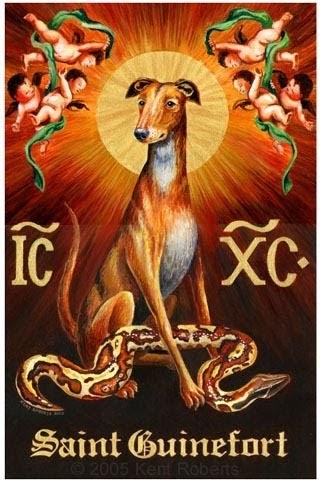 Years ago while in Lyon, France, I stumbled onto what the locals told me was a “healing” well. It was named after my favorite medieval saint: Saint Guinefort.
Years ago while in Lyon, France, I stumbled onto what the locals told me was a “healing” well. It was named after my favorite medieval saint: Saint Guinefort.
In the thirteenth century, a Dominican friar, Etienne de Bourbon was preaching near Lyon, when he heard during confession that many of the local women had taken their children to Saint Guinefort. Etienne had never heard of this saint, and wanted to learn more, so he investigated.
Much to his surprise, he discovered that Saint Guinefort was actually a dog . . . a greyhound, in fact. As the hagiography of Guinefort goes, he was a dog on a large estate. One day, when his master and mistress had left the house, a snake entered into the castle and began to approach the baby’s cradle. Guinefort attacked and killed the snake, and was badly hurt himself in the fight. He stayed to guard the cradle, and so when the parents returned, they found the cradle knocked over, and both dog and cradle covered in blood. Assuming that Guinefort had attacked the baby, the lord killed him with his sword—only to find the baby safe and unharmed, and the corpse of the serpent torn to pieces. Realizing their error, they made a shrine for the unjustly slain Guinefort, and began to venerate it. Etienne was none too impressed with the locals’ veneration of a dog as a saint, so he made them destroy the shrine and burn the remains of Guinefort—but that apparently did not end the cult of St. Guinefort, because it survived all the way into the twentieth century. If this story seems familiar, it may be because a version of it is found in the Disney film, Lady and the Tramp.
Animals have been the spiritual companions of humans since the beginning of recorded time. The earliest indication of the spiritual significance of the human-animal relationship can be found in the 20,000 year-old cave wall painting of Cro-Magnon people.
In many if not most cultures, animals have served a variety of spiritual functions: They have acted as guardians and shamans, and have appeared in images of an afterlife. Many ancient creation myths depict God with a dog.
That animals touch us in a deep and meaningful place is not a new phenomenon, but one that pervades the history of the human-animal relationship. Throughout history, they have offered us something fundamental: a direct and immediate sense of both joy and love. We recognize that animals seem to feel more intensely and purely than we do. I know I yearn to express myself with such abandon and integrity.
In having a relationship with our animals we can recover that which is true within us and, and through the discovery of that truth, find our spiritual direction. Simply, animals teach us about love: how to love, how to enjoy being loved, and how loving generates more love.
They teach us the language of the spirit. Animals can’t “talk” to us, yet they communicate with us and commune with us in a language that does not require words, rather feelings. They help us to understand that words can be limiting. Animals offer the unique opportunity to transcend the boundaries of our human perspectives; they allow us to stretch our consciousness toward an understanding that enables us to grow beyond our narrow viewpoint.
I see animals as the spiritual guardians or keepers on the planet. They never lose their awareness of themselves as spirit and their innate connection to all of life. Of all species, humans appear to need the most education to master their existence. Humans, unlike most animals, struggle with their analytical complexity and fail to see or even acknowledge themselves as spiritual beings.
I think Will Rogers sums up my feelings perfectly when he said, “If there are no dogs in heaven, then when I die I want to go where they went.” Indeed and some day, I look forward to meeting St. Guinefort.

Leave a Reply